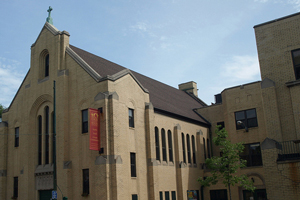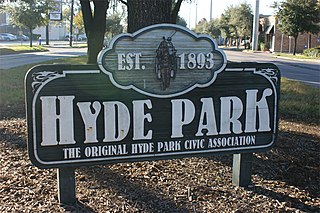Related Research Articles

Hull House was a settlement house in Chicago, Illinois, that was co-founded in 1889 by Jane Addams and Ellen Gates Starr. Located on the Near West Side of Chicago, Hull House, named after the original house's first owner Charles Jerald Hull, opened to serve recently arrived European immigrants. By 1911, Hull House had expanded to 13 buildings. In 1912, the Hull House complex was completed with the addition of a summer camp, the Bowen Country Club. With its innovative social, educational, and artistic programs, Hull House became the standard bearer for the movement; by 1920, it grew to approximately 500 settlement houses nationally.

The Houston Museum District is an association of 19 museums, galleries, cultural centers and community organizations located in Houston, Texas, dedicated to promoting art, science, history and culture.

River Oaks Elementary School is a magnet school, and neighborhood school, part of the Houston Independent School District. It is located in the River Oaks neighborhood of Houston, Texas, United States As of 2022, Brett Gallini is the principal.

Glenwood Cemetery is located in Houston, Texas, United States. Developed in 1871, the first professionally designed cemetery in the city accepted its first burial in 1872. Its location at Washington Avenue overlooking Buffalo Bayou served as an entertainment attraction in the 1880s. The design was based on principles for garden cemeteries, breaking the pattern of the typical gridiron layouts of most Houston cemeteries. Many influential people lay to rest at Glenwood, making it the "River Oaks of the dead." As of 2018, Glenwood includes the annexed property of the adjacent Washington Cemetery, creating a total area of 84 acres (34 ha) with 18 acres (7.3 ha) still undeveloped.

Second Ward is a historical political district ward in the East End community in Houston, Texas. It was one of the four original wards of the city in the nineteenth century. The community known as the Second Ward today is roughly bounded by Buffalo Bayou to the north, Lockwood Avenue to the east, and railroad tracks to the south and west, although the City of Houston's "Super Neighborhood" program includes a section east of Lockwood.

Magnolia Park is an area of the East End, Houston, Texas, located near the Houston Ship Channel. One of the oldest Hispanic neighborhoods in the City of Houston, Magnolia Park was formerly incorporated as the City of Magnolia Park in eastern Harris County.

Gulfton is a community in Southwest Houston, Texas, United States3.2 sq mi (8.3 km2). It is located between the 610 Loop and Beltway 8, west of the City of Bellaire, southeast of Interstate 69/U.S. Highway 59, and north of Bellaire Boulevard.

Lenox Hill Neighborhood House is a multi-service community-based organization that serves people in need on the East Side of Manhattan and on Roosevelt Island. Founded in 1894 as a free kindergarten for the children of indigent immigrants and as one of the first settlement houses in the nation, Lenox Hill Neighborhood House is the oldest and largest provider of social, legal and educational services on Manhattan's Upper East Side. Each year, they assist thousands of individuals and families who range in age from 3 to 103, represent dozens of races, ethnicities and countries of origin and "live, work, go to school or access services" on the East Side from 14th Street to 143rd Street and on Roosevelt Island. Their clients include indigent families and the working poor who live in the East Side's housing projects and tenements or who travel to the Upper East Side to work in low-wage jobs such as cashiers, housekeepers, nannies and laborers; 10,000 seniors; and hundreds of mentally ill homeless and formerly homeless adults. They have five locations between 54th and 102nd Streets, offer programs at dozens of East Side locations; their headquarters is located on East 70th Street.

James Addison Baker was an American attorney and banker in Houston, Texas. He was born James Addison Baker, Junior, and "Junior" appeared in his signature for many years. After the death of his father in 1897, he started signing his name "Captain James A. Baker," and from that point on people referred to him as Captain Baker.

East Downtown Houston (EaDo) is a district in Houston, Texas. The East Downtown Management District (EDMD), manages the area with offices headquartered at START Houston, a co-working space 1121 Delano Street. The community is located east of Downtown Houston and north of Interstate 45. It is between the George R. Brown Convention Center and the East End district.

James Addison Baker was a state legislator, state judge, and a lawyer. He is the first of four generations of persons named James Addison Baker, all of whom practiced law. He was known as "Judge Baker" after 1864. His son, also named James A. Baker, was a personal attorney for William Marsh Rice; and his great-grandson is James Baker, former President's Chief of Staff and former Secretary of State.

Broadacres is a subdivision in Houston, Texas, United States, within the Boulevard Oaks community. It is located north of Bissonnet Street, south of U.S. Route 59, west of the Houston Museum District, and east of other subdivisions of Boulevard Oaks. The neighborhood is known for its large lots, historic preservationism, broad tree canopies, wide streets with medians, and affluence.

Erie Neighborhood House is a social service agency that works primarily with low-income, immigrant families in Chicago, Illinois. Operations began in 1870 as a ministry of Holland Presbyterian Church, a Protestant congregation located northwest of Chicago's Loop, and the organization quickly became part of the settlement house movement that emerged in the late 19th century. It currently offers programs and services from four locations—two in Chicago's West Town community area, a third in Little Village, and fourth at Jose De Diego Elementary School in East Humboldt Park—to a population characterized as predominantly Latino.

Hyde Park is a historic community located in the Montrose neighborhood of Houston, Texas. Its southeast boundary is the intersection Montrose Boulevard and Westheimer. The neighborhood was established in the late 1800s on the summer farm of the second President of the Republic of Texas, Mirabeau Lamar. In the 1970s, Hyde Park became a central part of the Gay Rights Movement in Houston. Like much of Montrose, the neighborhood is now experiencing significant gentrification, and is home to an abundance of restaurants, including Mexican, Italian, Greek, American, Lebanese, coffee houses, and numerous bars.

Ella J. Baker Montessori School, formerly Woodrow Wilson Montessori School and Woodrow Wilson Elementary School, is a public K-8 Montessori school in the Cherryhurst Addition subdivision in the Neartown area of Houston, Texas. A part of the Houston Independent School District (HISD), Baker serves as the neighborhood elementary school for a section of Neartown, including a portion of Montrose. It also serves as a magnet school for all of HISD's territory. As of 2014 it is one of three public Montessori programs in Houston. It was the first HISD school to use the Montessori style for all students, as well as housing HISD's first Montessori middle school program.
Courtlandt Place, Houston is a residential subdivision consisting of a single street, south of downtown Houston, planned in 1906. Courtlandt Place is a member of the Neartown Houston Association.
Alice Graham Baker was an American civic leader, social worker, and philanthropist. She was the founding president of the Houston Settlement Association. She was married to Captain James A. Baker, who collaborated with her in civic ventures. She was the grandmother of James Addison Baker III, former United States Secretary of State and former Secretary of Treasury.

The Arthur B. Cohn House is a property listed on the National Register of Historic Places located in downtown Houston. The house is now about a block away from its original location at 1711 Rusk Avenue to the 600 block of Avenidas de las Americas, adjacent to Minute Maid Park, and will shortly be moved to a former parking lot site at the corner of Commerce and Hamilton Streets. The Queen Anne house was built for Cohn in 1905 by local architect, Michael DeChaumes.

Susan V. Clayton Homes was a public housing unit in the Second Ward area of the East End district of Houston. Operated by the Houston Housing Authority (HHA), formerly the Housing Authority of the City of Houston (HACH), it was along Runnels Street, along the Buffalo Bayou and east of Downtown Houston. It was adjacent to railroad tracks and warehouses. It had 296 units.
References
- 1 2 3 4 Kirkland, Kate Sayen (2012). Captain James A. Baker of Houston, 1857–1941. College Station: Texas A&M University Press. pp. 232–234.
- 1 2 3 McWhorter, Thomas (2011). "Trailblazers in Houston's East End:The Impact of Ripley House and the Settlement Association on Houston's Hispanic Population" (PDF). Houston History. 9 (1): 9–13.
- ↑ Kirkland (2012), pp. 335–336.
- ↑ Lewis, Brooke A. (16 February 2018). "Non-profit Neighborhood Centers changes name to BakerRipley". Houston Chronicle. Retrieved 23 July 2018.
- ↑ "Leadership: Executive Team". BakerRipley. Retrieved 23 July 2018.
- ↑ Hazen, Rebecca (8 April 2019). "Houston area nonprofit BakerRipley offers affordable youth summer programs". The Houston Chronicle. Retrieved 1 February 2020.
